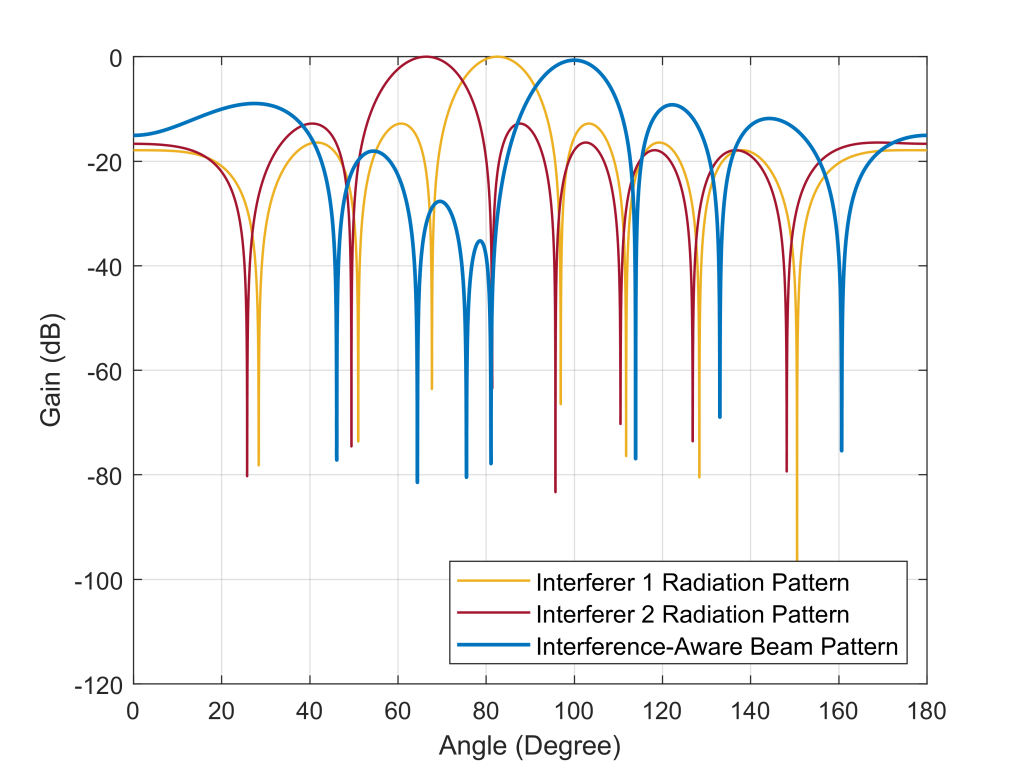Online Beam Learning for Interference Nulling in Hardware-Constrained mm Wave MIMO Systems
A mmWave base station is communicating with its target user under the presence of non-cooperative interference transmitters.
Key ideas
- Leveraging a reinforcement learning based framework to learn the interference nulling beam patterns in an online fashion
- Using the power measurements to intelligently adjust the analog phase-shifter configurations and do not need any channel knowledge of both the target user and the interference transmitters
- Evaluating the achieved SINR by only asking the target user to be on and off and do not need to coordinate with the interference transmitters
Applications
- Learning interference-aware beam patterns that can significantly improve the system throughput in the interference-limited scenarios
- Enabling a variety of applications such as fixed wireless, mmWave fronthaul, integrated sensing and communication, beamforming-based self-interference cancellation, etc.
More information about this research direction
Paper: Y. Zhang and A. Alkhateeb, “Online Beam Learning for Interference Nulling in Hardware-Constrained mmWave MIMO Systems,” 2022 56th Asilomar Conference on Signals, Systems, and Computers, Pacific Grove, CA, USA, 2022, pp. 200-204, doi: 10.1109/IEEECONF56349.2022.10051931.
Abstract: Employing large antenna arrays is a key characteristic of millimeter wave (mmWave) and terahertz communication systems. Due to the hardware constraints and the lack of channel knowledge, codebook based beamforming/combining is normally adopted to achieve the desired array gain. Existing codebooks, however, are typically pre-defined and focus only on improving the beamforming gain of their target user, without taking interference into account, which incurs critical performance degradation. In this paper, we propose an efficient deep reinforcement learning approach that learns how to iteratively optimize the beam pattern to null the interference. The proposed solution achieves that while not requiring any explicit channel knowledge of the desired or interfering users and without requiring any coordination with the interferers. Simulation results show that the developed solution is capable of finding a well-shaped beam pattern that significantly suppresses the interference while sacrificing negligible beamforming/combing gain, highlighting a promising solution for dense mmWave/terahertz networks.
@INPROCEEDINGS{10051931,
author={Zhang, Yu and Alkhateeb, Ahmed},
booktitle={2022 56th Asilomar Conference on Signals, Systems, and Computers},
title={Online Beam Learning for Interference Nulling in Hardware-Constrained mm Wave MIMO Systems},
year={2022},
volume={},
number={},
pages={200-204},
doi={10.1109/IEEECONF56349.2022.10051931}}
To reproduce the results in this paper:
Example: Steps to generate the results in this figure
- Download all the files of the GitHub repository given above.
- Run main.py in interference_beam_learning directory.
- Run step_2_plot.m in MATLAB.

